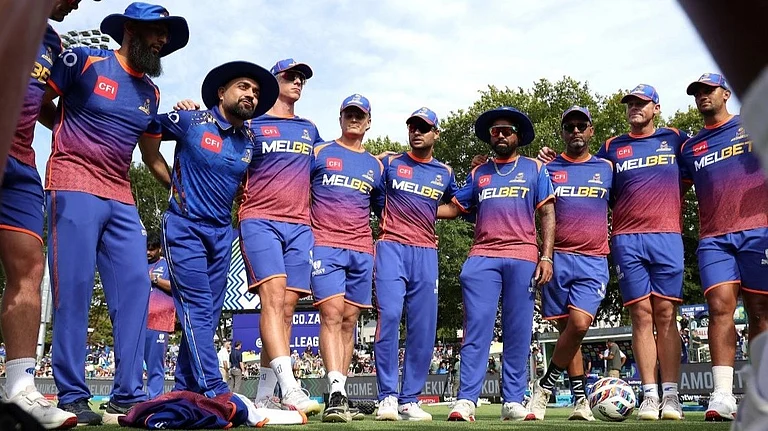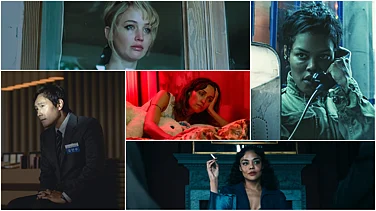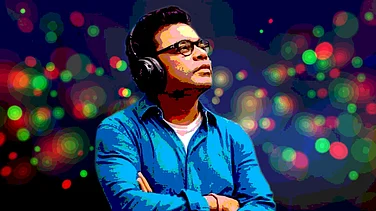The Oxford Dictionary defines ‘idealism’ as “the belief that a perfect life, situation, etc can be achieved, even when this is not very likely” and as “the unrealistic belief in our pursuit of perfection”. If one looks at idealism as arising out of an individual’s or society’s relationship with time, it involves a yearning to break with the past and a dream about the future; and both call for an intense engagement with the present. Art, even while it unfolds in the present, draws from the past and imagines futures, both utopias and dystopias. It invariably leaves its traces in thematics and narratives; one can find it in an auteur’s body of work and in the variations of a theme or a motif that persists through time.
Auteurs Of The Nation
Satyajit Ray, one of the greatest film chroniclers of the idea, ideal and reality of India, died on April 23, 1992. The date is significant as it marks a critical juncture in Indian history; the nation was undergoing some of the most transformative and traumatic events since independence. Manmohan Singh announced the New Economic Policies that ushered in globalisation, privatisation and liberalisation nine months before Ray’s death. They marked a definitive departure from Nehruvian economic ideals, and were to have a far-reaching impact upon economy and society in the decades to come. Babri Masjid was demolished eight months after Ray departed—and it was an event that left the secular democratic fabric of Indian polity tattered and severely challenged.
Ray’s oeuvre, spanning four tumultuous post-independence decades, presents layered and nuanced narratives about the Nation and the people. The trajectory of his romance with idealism can be captured through a cursory examination of the two trilogies that mark the beginning and end of his career—the Apu trilogy that includes Pather Panchali (Song of the Road/1955), Aparajito (Unvanquished/1956) and Apur Sansar (The World of Apu/1959), and his last three films: Ganashatru (Enemy of the People/1990), Shakha Proshakha (Branches of a Tree/1992) and Agantuk (The Visitor/1992).
The Apu trilogy follows three phases in the life of its protagonist Apu—a spatio-temporal journey from childhood through adolescence to youth, and also from the village to the holy town of Benaras and finally to the modern city of Calcutta. It is also an inner journey for Apu, who goes from a happy and innocent boy frolicking in the open spaces of the village with his sister Durga, to a moody, but ambitious student exploring the magic of the city, and later as a carefree young man, who wants to be free and pursue his literary passion. At the end of the trilogy, he comes back to reclaim his son, and we see both embarking on a journey which has no definite destination or predetermined goal. It is a journey into a world that has tragic potential, but is also full of hope and opportunities. The story of Apu resonates with a kind of indomitable idealism, one that has immense faith in life and the world despite bereavements, deprivations and challenges; it obviously resonates with the youthful energy and Nehruvian optimism of the young, post-Independence nation.
Cut to Ray’s last three films, made at the fag-end of his life. For the most part, these narratives unfold in the interiors (a conscious choice due to his medical condition), and were about aged men. Ganashatru, an adaptation of the Ibsen play, is about an idealist doctor who fights a valiant battle against the corrupt powers-that-be around him. The ‘holy water’ from the temple in his pilgrimage town is polluted and could soon cause an epidemic. The doctor blows the whistle but all arms of the Establishment—spiritual, bureaucratic, legislative, and that of media—conspire against him to silence him. Shakha Proshakha is about an idealist industrialist on his death bed, who is visited by his four sons and their family. What devastates the patriarch more than his impending death is his realisation about the corruption that has seeped into the lives of his offspring. Agantuk again has an old man, bitten by wanderlust in his youth, who returns to his home town Calcutta to spend a few days with his blood relations. A ‘worldly’ man in the profoundest sense of the term, he is astounded and revolted by the level of suspicion and inhospitality that ‘welcomes’ him at home.

(Clockwise from left) Satyajit Ray’s Pather Panchali, Apur Sansar, Ganashatru
If the Apu trilogy was about a gradual opening out to the world, the farewell trilogy is marked by an overwhelming sense of disillusionment, degeneration and corruption looming over everything. If there is melancholic youthfulness in the Apu films, one that’s ready to explore and take on the world even when it is harsh and bleak, in the last films, the world is aged and sick, and there is a gradual closing in of the narrative universe, spatially and socially: Ganashatru is about a small pilgrim town, Shakha Proshakha is about a joint family with a patriarch at the centre, and Agantuk is about a nuclear family that has insulated itself from the world. “Don’t be a koop manduk (frog in the well)” is the parting advice of the departing guest to the child in the family.
References to the rise of blind communal forces that are manipulating the mind, heart and soul of the people recur in all these films: both the idealist doctor who stands for reason and scientific temper, and the wanderer who wants openness, tolerance, humanism and rationality to prevail are pilloried about their stand on religion and faith. These protagonists of a bygone era of idealism are pushed to the corner and interrogated like criminals. A staunch Nehruvian idealist that Ray was, his last films are an indication of the depth and intensity of his despair about the times, and the predicament of the nation he was narrating throughout his oeuvre.
Now, let us look at the oeuvre of Adoor Gopalakrishnan, a contemporary filmmaker and successor to Ray, who began his career when Nehruvian idealism was on the backfoot and only a couple of years before that dark authoritarian interlude in Indian political history—the National Emergency. His first film, Swayamvaram (1972), was about a couple running away to the city to build a life of their own. Swayamvaram means ‘one’s own choice’ and, as the narrative unfolds, we find their choices gradually shrinking and dreams falling apart. But behind the bleak surface, there is an undercurrent of hope and struggle to survive; the woman’s unflinching stare at the audience at the end of the film is one of defiance and overcoming, not of surrender and despair. His latest film Pinneyum (Once Again/2016), returns to that theme—the struggle of a couple to survive in this hostile world. But here, there is not an iota of idealism or ethics left in this world. The protagonist, in his greedy search for shortcuts in life, goes to the length of murdering a random youth to steal insurance money and lives incognito, hoping for a return that never happens. The hesitant but complicit woman suffers all the ignominy to hold the rest of her life and family together. From the idealist lovers of Swayamvaram, Viswam and Sita, to the practical and doomed couple of Pinneyum, the distance—ethical and human—is huge and abysmal. In a way, Adoor seems to take off from Ray’s anguish and explores its despairing depths in the current world and time.

Adoor Gopalakrishnan’s Swayamvaram
Order! Order! Courting Idealism
Idealism is related to the idea of justice, which is an incessant process of expanding awareness and rebellions against unfreedoms of various kinds. And the site that reflects and enacts the changing ethical and idealist conflicts in Indian cinema is the courtroom; it is a recurring site of pleas and appeals, argumentation and conflicts about law, justice and order, where trials are carried out, arguments heard, evidences laid out and judgements pronounced. It is an ideal arena where the struggle between the polar abstractions of good and evil, justice and crime, what is and what ought to be are played out. From the beginning, courtroom drama was part of Indian cinema, especially in the genre of ‘socials’. The court, the seat and fount of justice, was a site that enabled the narrative to elaborate upon the idea of justice vis-a-vis the powers that be; in film after film, it provided the platform for idealism to speak out against the System, voicing anger, dreams, ideals and frustrations; it spoke for justice (idealist and futuristic) as against law (status quoist and of the present).
In early films, it appeared as a site of trenchant critique of the colonial order, often arguments of a colonial subject that now resonated with nationalist fervour and the spirit of freedom (Pukar/Sohrab Modi/1939; Ram Rajya/Vijay Bhatt/1943; Shaheed/Ramesh Saigal/1948). In the new, independent India, they began to articulate the aspirations of citizens; they argued for and dreamt of a just and equitable world, and advocated ideals of justice that were expected of/from the new nation (Aawara/Raj Kapoor/1951; Kanoon/B.R. Chopra/1960). In these films, courts were sites of appeal to the state power, reminding and pleading with it to live up to the promises of the anti-colonial and nationalist struggles. The breathless courtroom speech of Sivaji Ganesan in the legendary Tamil movie Parasakthi (R. Krishnan, S. Panju/1952), that launched his acting career, is a striking example from the period. The passionate defence by Gunasekharan’s character is an appeal for justice from the State against the violence and humiliation inflicted upon the common man by the legal, religious and economic system. In a similar vein, Malayalam movie Rarichan Enna Pouran (Citizen Rarichan/ P. Bhaskaran/1955) culminates in a courtroom scene where the advocate arguing for the adolescent Rarichan, accused of stealing, poses a disturbing question to the judge (and the audience)—who made him a thief? One encounters such culminations in several films of the period from all over India.

Adoor Gopalakrishnan’s Pinneyum
In the third phase of the post-Emergency era, there was an all-pervasive sense of disillusionment and despair. An overwhelming sense of despair marks these courtroom dramas. For instance, films like Insaf ka Tarazu (B.R. Chopra/1980) and Damini (Rajkumar Santoshi/1993) etc, voiced their anguish about the state of women within the family, society, economy and the nation; films like Mohan Joshi Hazir Ho!(Saeed Mirza/1984) dealt with the frustrating ways in which the Indian legal system got around justice without ever delivering it to the common man. Aakrosh (Govind Nihalani/1980) was a devastating critique on how the subaltern classes have been kept out of the orders of justice of all kinds, social, political and economic. The new millennium and the expectations and promises fuelled by globalisation saw the emergence of the Market as the sole new dispenser of equality and justice, where convoluted ethical argumentation and the tortuous legalities of the court seem to begin to lose their relevance and sanctity. Courts begin to lose their aura and, most importantly, their status as dispensers of justice, and as a site where competing claims of civil society could be expressed and settled, as Court (Chaitanya Tamhane/2015) powerfully and heartbreakingly shows. In Aakrosh, the subaltern peasant played by Om Puri is silenced and silent; he is muted by the brute power of caste and the economic and political order, he does not entertain any hope of getting justice from it. On the other, in Court the subaltern voice of Narayan Kamble, the Dalit activist, is loud, clear and rebellious, but his voice is never heard or listened to within a legal matrix that caters only to the privileged.

(Clockwise from top left) Damini, Kanoon, Insaf Ka Tarazu, Parasakthi
Idealist Cries Of Despair
We are living in a post-truth age where idealism as an imagination or yearning for an egalitarian world is at its lowest ebb. What we encounter at the centre of many ‘successful’ contemporary films are individuals fired by personal ambitions and the will to succeed. But their aspirations and dreams are devoid of the social; personal is the beginning and end of their horizon. Another kind of imagination that accompanies this ‘market aesthetics’ is one turned towards itself; it has eyes only for an imagined past that never was, and a future that includes only mirror images of itself, with no space for the ‘other’. They cultivate and celebrate a demonic variety of social and historical amnesia where idealism—if it is imagination about possible futures—is totally redundant. But running parallel to these celebrations of narcissism are narratives of human despair, especially of the subaltern classes. Films like Masaan, Sairat, Anhey Ghore Da Daan, Papillio Buddha, Khwada, Chauranga, Visaranai, Thithi, Fandry and Court, among others, rage against the oppressive sediments of the past and its hegemonic legacies in the present. Their narratives are filled with a kind of unbearable void that they elaborate upon and rebel against; one can sense in them the pulsations of a new and vibrant idealism that will strike new paths and visions of the future.


























